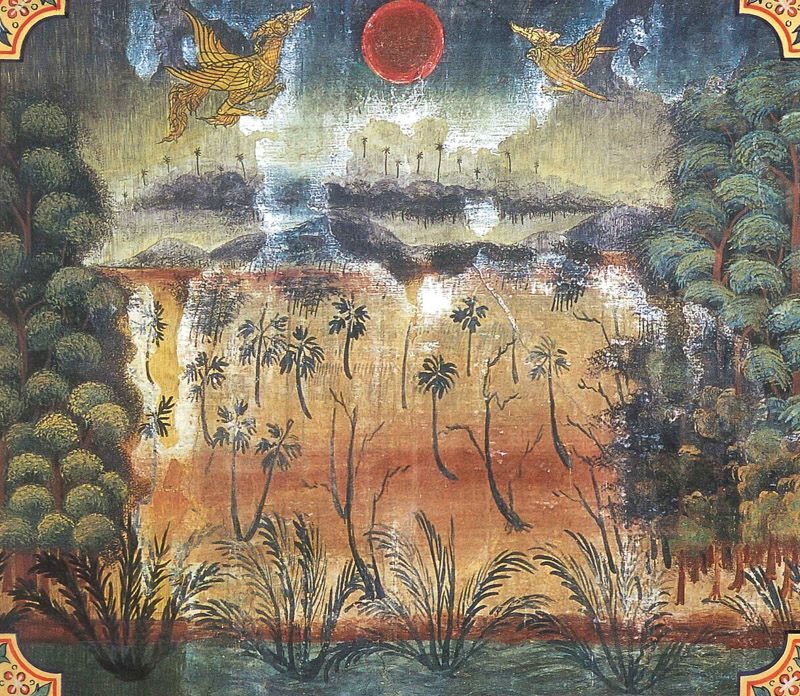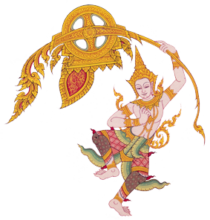
The Bodhisatta was once a goose, the king of a flock of ninety thousand. The King of Varanasi once saw the Bodhisatta and his flock flying across the sky and guessed that he too was a king. Wanting to meet this special goose, the king gathered garlands, perfumes, and lotions and set out in a procession with many musicians to find him. Thankful for the esteem he expressed, the Bodhisatta befriended the king, and one time even sprinkled him with water and sandalwood powder. The king loved him so much that he would sometimes sit and watch the sky, hoping the Bodhisatta would come that day.
One time the two youngest geese in the Bodhisatta’s flock planned to fly a race against the sun. The Bodhisatta told them they would die if they tried, and he ordered them not to go. But the young geese were fools and wouldn’t listen. One morning before sunrise, they snuck off to a mountain peak, and when the sun rounded the horizon, they flew off. But the Bodhisatta heard about it and joined them.
Not long after they set out, the youngest goose felt faint, so the Bodhisatta put him on his back and took him home, then quickly flew back to the other. The second young goose grew faint just before midday and was also rescued by the Bodhisatta. Since he had already flown with the sun for half the day, the Bodhisatta decided to finish the race, and he circled the whole globe while the sun remained in the sky. While flying, the Bodhisatta pondered the pointlessness of racing, so when he was done, he went off to give the king a lesson on righteousness.
When the Bodhisatta landed at the palace, the king brought his friend a golden seat, fed him sweet rice and sugared water, and rubbed him with refined ointments. He told the king about his day, and the king asked to see him fly faster than the sun. The Bodhisatta said it was not possible for a person to see this, but he came up with a demonstration. The king’s four best archers stood with their backs against a stone column in the royal courtyard and simultaneously shot arrows in the four directions. The Bodhisatta sat atop the column with a bell around his neck, caught all four arrows before they reached the ground, laid them at the archers’ feet, and returned to his perch. He flew so fast that the king never saw him move, but he did hear the tinkling of the bell.
The impressed king asked if anything was faster than the Bodhisatta. He answered that the decay of elements of life in living beings is one hundred thousand times faster; the world of form is constantly crumbling away, he explained, and everyone dies.
Pondering his own inevitable death, the king fainted. When he was brought around, he asked the Bodhisatta to stay in the city and be his teacher, helping him live in righteousness. The Bodhisatta answered that friendship is fleeting, and if he lived in the palace, the king would lose interest in him, and might even get drunk and eat him. Saying he would probably return again someday to visit, the Bodhisatta flew back to his mountain home.
In the Lifetime of the Buddha
One time the Buddha told the Parable of the Strong Men to his followers. Imagine four archers of great skill standing at the four points of the compass and shooting arrows in the four directions, he told them, and a man being able to catch all four arrows before they fell to the ground. This man would have perfect swiftness. But there is something faster than this man and even faster than the gods who can outrun the sun and moon: the decay of the elements that make up life. And because death is coming, you must learn to be careful.
Two days later, the Buddha heard some of his disciples discussing how great he was for giving such a brilliant lesson on impermanence. He told them it was not a significant feat because Buddhas possess perfect knowledge. Then he told this story to show he had once done the same thing before he reached omniscience as a Buddha.
The king was an earlier birth of Ananda and the two young geese were earlier births of Moggallana and Sariputta, three of the Buddha’s top disciples. The other geese of the flock were earlier births of the Buddha’s followers.
